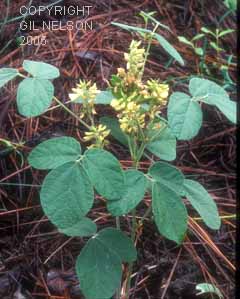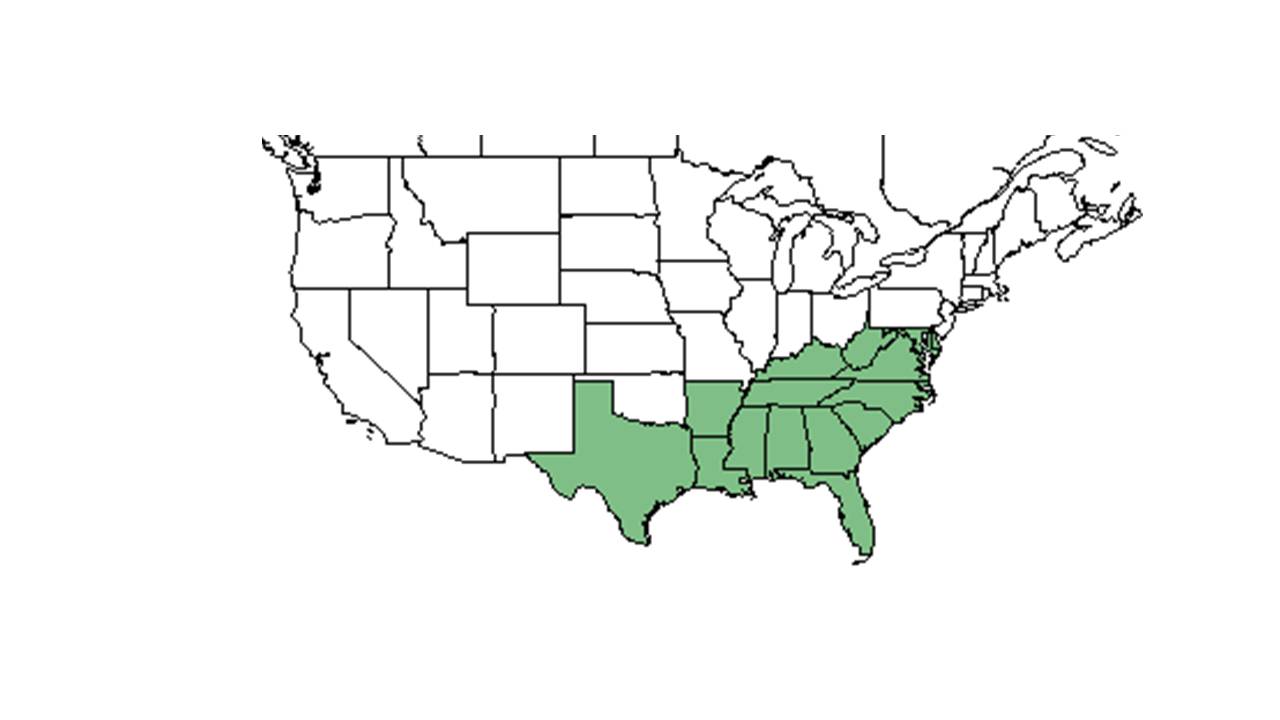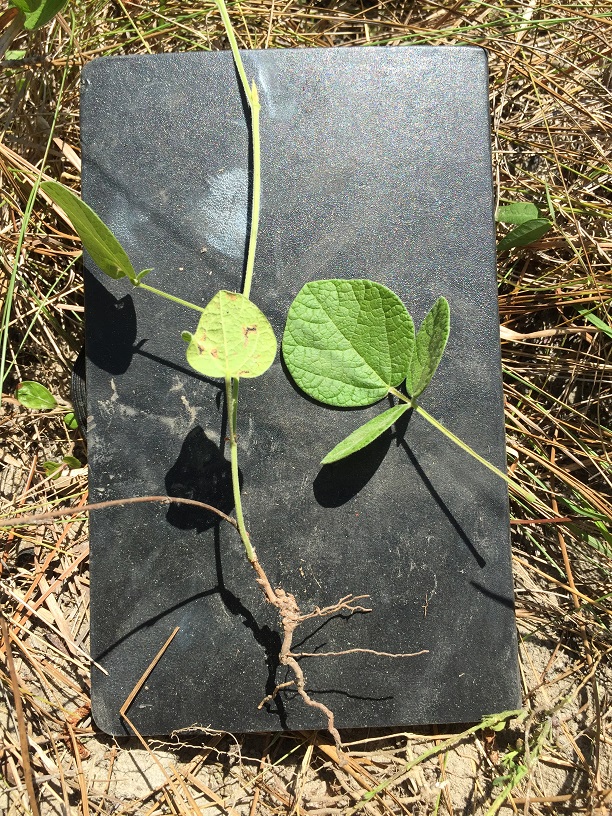Difference between revisions of "Rhynchosia tomentosa"
HaleighJoM (talk | contribs) (→Ecology) |
|||
| (45 intermediate revisions by 9 users not shown) | |||
| Line 15: | Line 15: | ||
| binomial_authority = (L.) Hook. & Arn. | | binomial_authority = (L.) Hook. & Arn. | ||
| range_map = RHYN_TOME_dist.jpg | | range_map = RHYN_TOME_dist.jpg | ||
| − | | range_map_caption = Natural range of ''Rhynchosia tomentosa'' from USDA NRCS [http:// | + | | range_map_caption = Natural range of ''Rhynchosia tomentosa'' from USDA NRCS [http://plants.usda.gov/core/profile?symbol=RHTO3 Plants Database]. |
}} | }} | ||
| + | |||
| + | Common name: Twining snoutbean (Nelson 2005) | ||
| + | ==Taxonomic notes== | ||
| + | Synonyms: ''Rhynchosia erecta'' (Walter) A.P. de Candolle; ''Rhynchosia intermedia'' (Torrey & Gray) Small.<ref>Weakley, A.S. 2015. Flora of the southern and mid-atlantic states. Working Draf of 21 May 2015. University of North Carolina at Chapel Hill, Chapel Hill, North Carolina.</ref> | ||
| + | |||
==Description== | ==Description== | ||
<!-- Basic life history facts such as annual/perrenial, monoecious/dioecious, root morphology, seed type, etc. --> | <!-- Basic life history facts such as annual/perrenial, monoecious/dioecious, root morphology, seed type, etc. --> | ||
| − | + | Is strongly paraheliotropic.<ref>[[KMR]] observation at Pebble Hill Plantation, Georgia in July.</ref> | |
| + | |||
| + | “Erect, trailing or climbing, perennial herbs or shrubs. Leaves pinnately 3-foliolate or occasionally 1-foliolate; leaflets usually entire and often bearing amber glands, usually estipellate; stipules ovate to lanceolate. Flowers papilionaceous, rarely solitary or in pairs but usually in axillary or occasionally also terminal racemes, several to numerous, loose to compactly clustered, pedicellate, each subtended by a caduceus bract. Calyx tube campanulate or tubular, nearly regular, lobes equal or nearly so in size but with the 2 uppermost partially united; petals yellow in ours, often equaling or even shorter than the calyx; stamens diadelphous, 9 and 1. Legume usually oblong and flattened, 1-2 seeded, dehiscent.”<ref name="Radford et al 1964">Radford, Albert E., Harry E. Ahles, and C. Ritchie Bell. Manual of the Vascular Flora of the Carolinas. 1964, 1968. The University of North Carolina Press. 638. Print.</ref> | ||
| + | |||
| + | "Erect herb (1.5) 3-9 m tall with terete to strongly angled, densely pubescent stems. Leaves 3-foliolate; leaflets ovate to oblong or rhombic-ovate, elliptic or obovate, 2-7 cm long, 1/3 to ½ as wide, conspicuously reticulate, moderately to densely short-pubescent, with few to numerous, inconspicuous glands above and velvety tomentose with numerous inconspicuous glands beneath, stipels lacking; stipules soon deciduous, linear-lanceolate, 4-10 mm long. Racemes axillary and terminal, 1.5- cm long, subsessile or on peduncles to 2 cm long with numerous, closely clustered flowers on pedicels 1-3 mm long subtended by linear-subulate to setaceous bract 2-8 mm long. Calyx densely pilose, abundantly but inconspicuously glandular the tube 1.5-2 mm long, lobes linear-subulate4-6 mm long, the upper 2 united for about ½ their length; petals yellow, 5-7 mm long. Legume 1.2-1.6 cm long, 5-7 mm broad, short-pubescent and inconspicuously glandular."<ref name="Radford et al 1964"/> | ||
| + | |||
==Distribution== | ==Distribution== | ||
| − | ''R. tomentosa'' was found in the study area “within the Upper Coastal Plain Ecoregion with nearly level to gently rolling topography and a maximum elevation of 240m.” | + | ''R. tomentosa'' was found in the study area “within the Upper Coastal Plain Ecoregion with nearly level to gently rolling topography and a maximum elevation of 240m.”<ref name="Archer et al 2007"> Archer, J. K., D. L. Miller, et al. 2007. Changes in understory vegetation and soil characteristics following silvicultural activities in a southeastern mixed pine forest. Journal of the Torrey Botanical Society 134: 489-504.</ref> |
| + | |||
==Ecology== | ==Ecology== | ||
===Habitat=== <!--Natural communities, human disturbed habitats, topography, hydrology, soils, light, fire regime requirements for removal of competition, etc.--> | ===Habitat=== <!--Natural communities, human disturbed habitats, topography, hydrology, soils, light, fire regime requirements for removal of competition, etc.--> | ||
| − | + | In the Coastal Plains, ''R. tomentosa'' can be found in pine-oak woodlands, old growth longleaf pine stands, frequently burned mature longleaf pine-wiregrass stands, longleaf pine sandhills, pine flatwoods, mature longleaf pine savanna, shady oak-hickory woods, hammocks, and calcareous glades.<ref name="FSU Herbarium">Florida State University Robert K. Godfrey Herbarium database. URL: [http://herbarium.bio.fsu.edu http://herbarium.bio.fsu.edu]. Last accessed: July 2015. Collectors: Loran C. Anderson, T. MacClendon, K. MacClendon, Brenda Herring, Don Herring, R. A. Norris, Rodie White, Richard R. Clinebell II, Robert Kral, Mabel Kral, Roy Komarek, John B. Nelson, A. Anrrich, Elias L Potagas, George R. Cooley, Carroll E. Wood, Jr., Robert K. Godfrey, K. Craddock Burks, Gwynn W. Ramsey, R. S. Mitchell, C. Jackson, Sidney McDaniel, G. Wilder, Roy Komarek, W. C. Coker, C. Ritchie Bell, R. L. Wilbur, James D. Ray, Jr., M. F. Buell, Jean Wooten, S. B. Jones, Carleen Jones, A. B. Seymour, H. R. Reed, A. F. Clewell, M. Morgan. States and Counties: Alabama: Baldwin, Cullman, Elmore, Jefferson, Marengo, Perry. Florida: Calhoun, Citrus, Columbia, Dixie, Gadsden, Hamilton, Jackson, Jefferson, Leon, Liberty, Nassau, Santa Rosa, Suwannee, Wakulla. Georgia: Baker, Grady, Seminole, Thomas, Turner. Mississippii: Clarke, Forrest, Jackson, Lawrence, Pearl River. North Carolina: Richmond, Robeson, Sampson, Wake, Warren. South Carolina: Darlington, Newberry. Compiled by Tall Timbers Research Station and Land Conservancy.</ref><ref name="Nelson 2005"/> It can also occur in recently burned scrubs of cutover pinewoods, former pine plantations, pastures, cut-over cedar glades, roadsides, near pond drains, old fields, powerline clearings, chalk prairies, and clearings of shortleaf pine stands.<ref name="FSU Herbarium"/> Soil types include sand, moist loamy soils, sandy loam, and loamy sand.<ref name="FSU Herbarium"/> | |
| + | |||
| + | Associated species include ''Pinus palustris, Aristida stricta, Magnolia, Quercus, Rhynchosia reniformis'' and ''R. difformis.''<ref name="FSU Herbarium"/> | ||
| + | |||
| + | ''Rhynchosia tomentosa'' is an indicator species for the Clayhill Longleaf Woodlands community type as described in Carr et al. (2010)<ref>Carr, S.C., K.M. Robertson, and R.K. Peet. 2010. A vegetation classification of fire-dependent pinelands of Florida. Castanea 75:153-189.</ref> | ||
| + | |||
===Phenology=== <!--Timing off flowering, fruiting, seed dispersal, and environmental triggers. Cite PanFlora website if appropriate: http://www.gilnelson.com/PanFlora/ --> | ===Phenology=== <!--Timing off flowering, fruiting, seed dispersal, and environmental triggers. Cite PanFlora website if appropriate: http://www.gilnelson.com/PanFlora/ --> | ||
| − | + | This species has been observed to flower from May through August<ref>Nelson, G. [http://www.gilnelson.com/ PanFlora]: Plant data for the eastern United States with emphasis on the Southeastern Coastal Plains, Florida, and the Florida Panhandle. www.gilnelson.com/PanFlora/ Accessed: 19 MAY 2021</ref>, and fruits May through October.<ref name="FSU Herbarium"/><ref name="Nelson 2005">Nelson, Gil. East Gulf Coastal Plain. a Field Guide to the Wildflowers of the East Gulf Coastal Plain, including Southwest Georgia, Northwest Florida, Southern Alabama, Southern Mississippi, and Parts of Southeastern Louisiana. Guilford, CT: Falcon, 2005. 184. Print.</ref> | |
| − | ===Seed dispersal=== | + | <!--===Seed dispersal===--> |
| − | ===Seed bank and germination=== | + | <!--===Seed bank and germination===--> |
===Fire ecology=== <!--Fire tolerance, fire dependence, adaptive fire responses--> | ===Fire ecology=== <!--Fire tolerance, fire dependence, adaptive fire responses--> | ||
| − | + | Populations of ''Rhynchosia tomentosa'' have been known to persist through repeated annual burns.<ref>Robertson, K.M. Unpublished data collected from Pebble Hill Fire Plots, Pebble Hill Plantation, Thomasville, Georgia.</ref><ref>Platt, W.J., R. Carter, G. Nelson, W. Baker, S. Hermann, J. Kane, L. Anderson, M. Smith, K. Robertson. 2021. Unpublished species list of Wade Tract old-growth longleaf pine savanna, Thomasville, Georgia.</ref> This species was observed as an understory plant from frequently burned old-growth mountain longleaf pine stands at Fort McClellan, Alabama.<ref name="Varner et al 2003">Varner, J. Morgan, John S. Kush, and Ralph S. Meldhal. 2003. Vegetation of Frequently Burned Old-Growth Longlef Pine (Pinus Palustris Mill.) Savannas on Choccolocco Mountain, Alabama, USA. Natural Areas Journal 23.1: 43-52.</ref> | |
| − | ===Pollination=== | + | <!--===Pollination===--> |
| − | === | + | <!--===Herbivory and toxicology===<!--Common herbivores, granivory, insect hosting, poisonous chemicals, allelopathy, etc--> |
| − | ===Diseases and parasites=== | + | <!--===Diseases and parasites===--> |
| − | ==Conservation | + | |
| − | + | ==Conservation, cultivation, and restoration== | |
| − | ''R. tomentosa'' was found to be an indicator species in areas 30-80 years after clear-cutting in a southeastern mixed pine forest | + | ''R. tomentosa'' was found to be an indicator species in areas 30-80 years after clear-cutting in a southeastern mixed pine forest.<ref name="Archer et al 2007"/> |
| + | |||
| + | ==Cultural use== | ||
==Photo Gallery== | ==Photo Gallery== | ||
| + | <gallery widths=180px> | ||
| + | File:Rhynchosia tomentosa MS.JPG| <center> ''Rhynchosia tomentosa'' <p> Photo by Michelle Smith</p> | ||
| + | File:Rhynchosia tomentosa.jpg| <center> ''Rhynchosia tomentosa'' root <p> Photo by Kevin Robertson </p> <p>Pebble Hill Plantation</p> <p>2015</p> | ||
| + | </nowiki></gallery> | ||
| + | |||
==References and notes== | ==References and notes== | ||
| − | |||
| − | |||
| − | |||
Latest revision as of 15:13, 15 July 2022
| Rhynchosia tomentosa | |
|---|---|

| |
| Photo taken by Gil Nelson | |
| Scientific classification | |
| Kingdom: | Plantae |
| Division: | Magnoliophyta – Flowering plants |
| Class: | Magnoliopsida – Dicotyledons |
| Order: | Fabales |
| Family: | Fabaceae ⁄ Leguminosae |
| Genus: | Rhynchosia |
| Species: | R. tomentosa |
| Binomial name | |
| Rhynchosia tomentosa (L.) Hook. & Arn. | |

| |
| Natural range of Rhynchosia tomentosa from USDA NRCS Plants Database. | |
Common name: Twining snoutbean (Nelson 2005)
Contents
Taxonomic notes
Synonyms: Rhynchosia erecta (Walter) A.P. de Candolle; Rhynchosia intermedia (Torrey & Gray) Small.[1]
Description
Is strongly paraheliotropic.[2]
“Erect, trailing or climbing, perennial herbs or shrubs. Leaves pinnately 3-foliolate or occasionally 1-foliolate; leaflets usually entire and often bearing amber glands, usually estipellate; stipules ovate to lanceolate. Flowers papilionaceous, rarely solitary or in pairs but usually in axillary or occasionally also terminal racemes, several to numerous, loose to compactly clustered, pedicellate, each subtended by a caduceus bract. Calyx tube campanulate or tubular, nearly regular, lobes equal or nearly so in size but with the 2 uppermost partially united; petals yellow in ours, often equaling or even shorter than the calyx; stamens diadelphous, 9 and 1. Legume usually oblong and flattened, 1-2 seeded, dehiscent.”[3]
"Erect herb (1.5) 3-9 m tall with terete to strongly angled, densely pubescent stems. Leaves 3-foliolate; leaflets ovate to oblong or rhombic-ovate, elliptic or obovate, 2-7 cm long, 1/3 to ½ as wide, conspicuously reticulate, moderately to densely short-pubescent, with few to numerous, inconspicuous glands above and velvety tomentose with numerous inconspicuous glands beneath, stipels lacking; stipules soon deciduous, linear-lanceolate, 4-10 mm long. Racemes axillary and terminal, 1.5- cm long, subsessile or on peduncles to 2 cm long with numerous, closely clustered flowers on pedicels 1-3 mm long subtended by linear-subulate to setaceous bract 2-8 mm long. Calyx densely pilose, abundantly but inconspicuously glandular the tube 1.5-2 mm long, lobes linear-subulate4-6 mm long, the upper 2 united for about ½ their length; petals yellow, 5-7 mm long. Legume 1.2-1.6 cm long, 5-7 mm broad, short-pubescent and inconspicuously glandular."[3]
Distribution
R. tomentosa was found in the study area “within the Upper Coastal Plain Ecoregion with nearly level to gently rolling topography and a maximum elevation of 240m.”[4]
Ecology
Habitat
In the Coastal Plains, R. tomentosa can be found in pine-oak woodlands, old growth longleaf pine stands, frequently burned mature longleaf pine-wiregrass stands, longleaf pine sandhills, pine flatwoods, mature longleaf pine savanna, shady oak-hickory woods, hammocks, and calcareous glades.[5][6] It can also occur in recently burned scrubs of cutover pinewoods, former pine plantations, pastures, cut-over cedar glades, roadsides, near pond drains, old fields, powerline clearings, chalk prairies, and clearings of shortleaf pine stands.[5] Soil types include sand, moist loamy soils, sandy loam, and loamy sand.[5]
Associated species include Pinus palustris, Aristida stricta, Magnolia, Quercus, Rhynchosia reniformis and R. difformis.[5]
Rhynchosia tomentosa is an indicator species for the Clayhill Longleaf Woodlands community type as described in Carr et al. (2010)[7]
Phenology
This species has been observed to flower from May through August[8], and fruits May through October.[5][6]
Fire ecology
Populations of Rhynchosia tomentosa have been known to persist through repeated annual burns.[9][10] This species was observed as an understory plant from frequently burned old-growth mountain longleaf pine stands at Fort McClellan, Alabama.[11]
Conservation, cultivation, and restoration
R. tomentosa was found to be an indicator species in areas 30-80 years after clear-cutting in a southeastern mixed pine forest.[4]
Cultural use
Photo Gallery
References and notes
- ↑ Weakley, A.S. 2015. Flora of the southern and mid-atlantic states. Working Draf of 21 May 2015. University of North Carolina at Chapel Hill, Chapel Hill, North Carolina.
- ↑ KMR observation at Pebble Hill Plantation, Georgia in July.
- ↑ 3.0 3.1 Radford, Albert E., Harry E. Ahles, and C. Ritchie Bell. Manual of the Vascular Flora of the Carolinas. 1964, 1968. The University of North Carolina Press. 638. Print.
- ↑ 4.0 4.1 Archer, J. K., D. L. Miller, et al. 2007. Changes in understory vegetation and soil characteristics following silvicultural activities in a southeastern mixed pine forest. Journal of the Torrey Botanical Society 134: 489-504.
- ↑ 5.0 5.1 5.2 5.3 5.4 Florida State University Robert K. Godfrey Herbarium database. URL: http://herbarium.bio.fsu.edu. Last accessed: July 2015. Collectors: Loran C. Anderson, T. MacClendon, K. MacClendon, Brenda Herring, Don Herring, R. A. Norris, Rodie White, Richard R. Clinebell II, Robert Kral, Mabel Kral, Roy Komarek, John B. Nelson, A. Anrrich, Elias L Potagas, George R. Cooley, Carroll E. Wood, Jr., Robert K. Godfrey, K. Craddock Burks, Gwynn W. Ramsey, R. S. Mitchell, C. Jackson, Sidney McDaniel, G. Wilder, Roy Komarek, W. C. Coker, C. Ritchie Bell, R. L. Wilbur, James D. Ray, Jr., M. F. Buell, Jean Wooten, S. B. Jones, Carleen Jones, A. B. Seymour, H. R. Reed, A. F. Clewell, M. Morgan. States and Counties: Alabama: Baldwin, Cullman, Elmore, Jefferson, Marengo, Perry. Florida: Calhoun, Citrus, Columbia, Dixie, Gadsden, Hamilton, Jackson, Jefferson, Leon, Liberty, Nassau, Santa Rosa, Suwannee, Wakulla. Georgia: Baker, Grady, Seminole, Thomas, Turner. Mississippii: Clarke, Forrest, Jackson, Lawrence, Pearl River. North Carolina: Richmond, Robeson, Sampson, Wake, Warren. South Carolina: Darlington, Newberry. Compiled by Tall Timbers Research Station and Land Conservancy.
- ↑ 6.0 6.1 Nelson, Gil. East Gulf Coastal Plain. a Field Guide to the Wildflowers of the East Gulf Coastal Plain, including Southwest Georgia, Northwest Florida, Southern Alabama, Southern Mississippi, and Parts of Southeastern Louisiana. Guilford, CT: Falcon, 2005. 184. Print.
- ↑ Carr, S.C., K.M. Robertson, and R.K. Peet. 2010. A vegetation classification of fire-dependent pinelands of Florida. Castanea 75:153-189.
- ↑ Nelson, G. PanFlora: Plant data for the eastern United States with emphasis on the Southeastern Coastal Plains, Florida, and the Florida Panhandle. www.gilnelson.com/PanFlora/ Accessed: 19 MAY 2021
- ↑ Robertson, K.M. Unpublished data collected from Pebble Hill Fire Plots, Pebble Hill Plantation, Thomasville, Georgia.
- ↑ Platt, W.J., R. Carter, G. Nelson, W. Baker, S. Hermann, J. Kane, L. Anderson, M. Smith, K. Robertson. 2021. Unpublished species list of Wade Tract old-growth longleaf pine savanna, Thomasville, Georgia.
- ↑ Varner, J. Morgan, John S. Kush, and Ralph S. Meldhal. 2003. Vegetation of Frequently Burned Old-Growth Longlef Pine (Pinus Palustris Mill.) Savannas on Choccolocco Mountain, Alabama, USA. Natural Areas Journal 23.1: 43-52.

